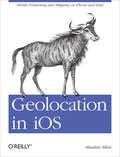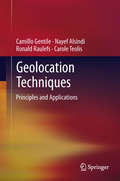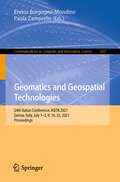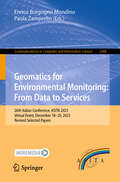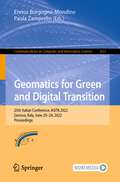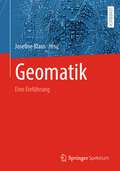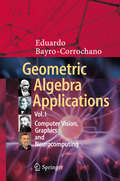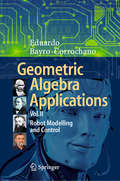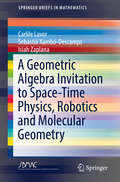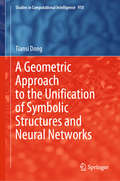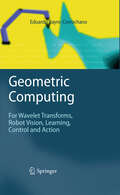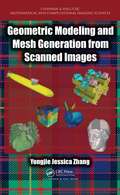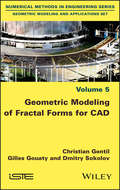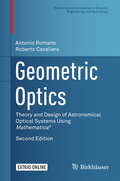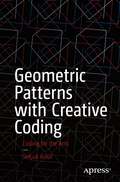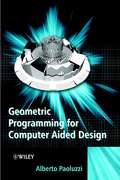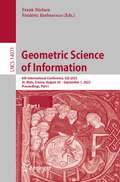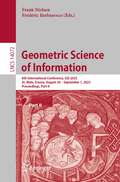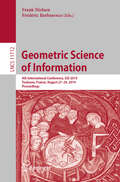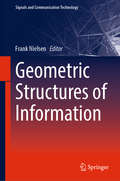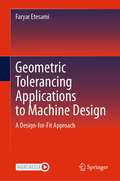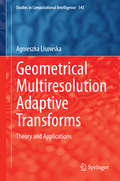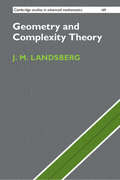- Table View
- List View
Geolocation in iOS
by Alasdair Allan<p>This concise hands-on guide takes you deep inside Apple’s Core Location framework, Map Kit, and other iOS tools, using illustrative examples and sample Objective-C code. Learn how to build location-aware apps for both iPhones and iPads, using code that detects hardware features and then adjusts your app’s behavior.</p>
Geolocation Techniques
by Camillo Gentile Ronald Raulefs Nayef Alsindi Carole TeolisBasics of Distributed and Cooperative Radio and Non-Radio Based Geolocation provides a detailed overview of geolocation technologies. The book covers the basic principles of geolocation, including ranging techniques to localization technologies, fingerprinting and localization in wireless sensor networks. This book also examines the latest algorithms and techniques such as Kalman Filtering, Gauss-Newton Filtering and Particle Filtering.
Geomatics and Geospatial Technologies: 24th Italian Conference, ASITA 2021, Genoa, Italy, July 1-2, 9, 16, 23, 2021, Proceedings (Communications in Computer and Information Science #1507)
by Enrico Borgogno-Mondino Paola ZamperlinThis volume constitutes selected papers presented at the 24th Italian Conference on Geomatics and Geospatial Technologies, ASITA 2021, held as five sessions takind place between 1 and 23 July, 2021. Due to the COVID-19 pandemic the conference was held online.The 28 papers were thoroughly reviewed and selected from 139 submissions. They are organized in topical sections on remote sensing applications; geomatics and natural hazards; geomatics for cultural heritage and natural resources; sensors performance and data processing; geomatics and land management.
Geomatics for Environmental Monitoring: 26th Italian Conference, ASITA 2023, Virtual Event, December 18–20, 2023, Revised Selected Papers (Communications in Computer and Information Science #2088)
by Paola Zamperlin Enrico Borgogno MondinoThis book constitutes the proceedings of the 26th Italian Conference on Geomatics for Environmental Monitoring: From Data to Services, ASITA 2023, which was held as a virtual event during December 18-20, 2023. The 19 full papers included in this book were carefully reviewed and selected from 42 submissions. They were organized in topical sections as follows: Natural hazards monitoring and modelling; technological services for territory planning and Management; methodological advancements in data analysis and processing.
Geomatics for Green and Digital Transition: 25th Italian Conference, ASITA 2022, Genova, Italy, June 20–24, 2022, Proceedings (Communications in Computer and Information Science #1651)
by Enrico Borgogno-Mondino Paola ZamperlinThis book constitutes the proceedings of the 25th Italian Conference on Geomatics for Green and Digital Transition, ASITA 2022, held in Genova, Italy, in June 2022.The 33 full papers included in this book were carefully reviewed and selected from 60 submissions. They were organized in topical sections as follows: Positioning, Navigation and Operational Geodesy; Data exploitation: services and tools; Geo(big)data, GeoAnalytics, AI and Decision Support; Agriculture and Forestry; Cultural Heritage and Landscape Analysis; Environmental Monitoring and Analysis; and Sustainable Development and Climate Change.
Geomatik: Eine Einführung
by Josefine KlausWas ist eine Mercatorabbildung? Wie berechnet man Koordinaten? Wie funktioniert ein Geoinformationssystem? Diese und viele weitere Fragen beantwortet „Geomatik - Eine Einführung“ und bietet damit zum ersten Mal die theoretischen Grundlagen der Ausbildung zur/zum Geomatiker:in in einem Werk.Folgende Themen werden auf der Grundlage des bundesweit einheitlichen Rahmenlehrplans der Berufsausbildung behandelt:Organisation des Vermessungswesen Erfassung, Bearbeitung und Präsentation von Geodaten Verwaltung von GeodatenGrundlagen des Web- und Printdesigns Selbstständige Entwicklung von GeoproduktenDie Inhalte werden ergänzt durch ein auf die Prüfungen angepasstes Lernangebot und zahlreiche weiterführende Informationsquellen. Dadurch entsteht ein umfassendes und zeitgemäßes Handbuch für den Berufsschulunterricht und zur Prüfungsvorbereitung im Bereich der Geoinformatik, Vermessung und Kartographie. Aus einer modernen, digitalen Wissensvermittlung sind die visuellen und kartenbasierten Ansätze der Geomatik nicht mehr wegzudenken. Die in diesem Buch angebotenen Informationen ermöglichen es angehenden Geomatiker:innen und Interessierten selbstständig eigene Geoprodukte zu erstellen.
Geometric Algebra Applications Vol. I: Computer Vision, Graphics and Neurocomputing
by Eduardo Bayro-CorrochanoThe goal of the Volume I Geometric Algebra for Computer Vision, Graphics and Neural Computing is to present a unified mathematical treatment of diverse problems in the general domain of artificial intelligence and associated fields using Clifford, or geometric, algebra.Geometric algebra provides a rich and general mathematical framework for Geometric Cybernetics in order to develop solutions, concepts and computer algorithms without losing geometric insight of the problem in question. Current mathematical subjects can be treated in an unified manner without abandoning the mathematical system of geometric algebra for instance: multilinear algebra, projective and affine geometry, calculus on manifolds, Riemann geometry, the representation of Lie algebras and Lie groups using bivector algebras and conformal geometry. By treating a wide spectrum of problems in a common language, this Volume I offers both new insights and new solutions that should be useful to scientists, and engineers working in different areas related with the development and building of intelligent machines. Each chapter is written in accessible terms accompanied by numerous examples, figures and a complementary appendix on Clifford algebras, all to clarify the theory and the crucial aspects of the application of geometric algebra to problems in graphics engineering, image processing, pattern recognition, computer vision, machine learning, neural computing and cognitive systems.
Geometric Algebra Applications Vol. II: Robot Modelling and Control
by Eduardo Bayro-CorrochanoThis book presents a unified mathematical treatment of diverse problems in the general domain of robotics and associated fields using Clifford or geometric alge- bra. By addressing a wide spectrum of problems in a common language, it offers both fresh insights and new solutions that are useful to scientists and engineers working in areas related with robotics. It introduces non-specialists to Clifford and geometric algebra, and provides ex- amples to help readers learn how to compute using geometric entities and geomet- ric formulations. It also includes an in-depth study of applications of Lie group theory, Lie algebra, spinors and versors and the algebra of incidence using the universal geometric algebra generated by reciprocal null cones. Featuring a detailed study of kinematics, differential kinematics and dynamics using geometric algebra, the book also develops Euler Lagrange and Hamiltoni- ans equations for dynamics using conformal geometric algebra, and the recursive Newton-Euler using screw theory in the motor algebra framework. Further, it comprehensively explores robot modeling and nonlinear controllers, and discusses several applications in computer vision, graphics, neurocomputing, quantum com- puting, robotics and control engineering using the geometric algebra framework. The book also includes over 200 exercises and tips for the development of future computer software packages for extensive calculations in geometric algebra, and a entire section focusing on how to write the subroutines in C++, Matlab and Maple to carry out efficient geometric computations in the geometric algebra framework. Lastly, it shows how program code can be optimized for real-time computations. An essential resource for applied physicists, computer scientists, AI researchers, roboticists and mechanical and electrical engineers, the book clarifies and demon- strates the importance of geometric computing for building autonomous systems to advance cognitive systems research.
A Geometric Algebra Invitation to Space-Time Physics, Robotics and Molecular Geometry (SpringerBriefs in Mathematics)
by Carlile Lavor Sebastià Xambó-Descamps Isiah ZaplanaThis book offers a gentle introduction to key elements of Geometric Algebra, along with their applications in Physics, Robotics and Molecular Geometry. Major applications covered are the physics of space-time, including Maxwell electromagnetism and the Dirac equation; robotics, including formulations for the forward and inverse kinematics and an overview of the singularity problem for serial robots; and molecular geometry, with 3D-protein structure calculations using NMR data. The book is primarily intended for graduate students and advanced undergraduates in related fields, but can also benefit professionals in search of a pedagogical presentation of these subjects.
Geometric and Topological Inference (Cambridge Texts in Applied Mathematics #57)
by Jean-Daniel Boissonnat Frédéric Chazal Mariette YvinecGeometric and topological inference deals with the retrieval of information about a geometric object using only a finite set of possibly noisy sample points. It has connections to manifold learning and provides the mathematical and algorithmic foundations of the rapidly evolving field of topological data analysis. Building on a rigorous treatment of simplicial complexes and distance functions, this self-contained book covers key aspects of the field, from data representation and combinatorial questions to manifold reconstruction and persistent homology. It can serve as a textbook for graduate students or researchers in mathematics, computer science and engineering interested in a geometric approach to data science.
A Geometric Approach to the Unification of Symbolic Structures and Neural Networks (Studies in Computational Intelligence #910)
by Tiansi DongThe unification of symbolist and connectionist models is a major trend in AI. The key is to keep the symbolic semantics unchanged. Unfortunately, present embedding approaches cannot. The approach in this book makes the unification possible. It is indeed a new and promising approach in AI. -Bo Zhang, Director of AI Institute, TsinghuaIt is indeed wonderful to see the reviving of the important theme Nural Symbolic Model. Given the popularity and prevalence of deep learning, symbolic processing is often neglected or downplayed. This book confronts this old issue head on, with a historical look, incorporating recent advances and new perspectives, thus leading to promising new methods and approaches. -Ron Sun (RPI), on Governing Board of Cognitive Science SocietyBoth for language and humor, approaches like those described in this book are the way to snickerdoodle wombats. -Christian F. Hempelmann (Texas A&M-Commerce) on Executive Board of International Society for Humor Studies
Geometric Computing
by Eduardo Bayro-CorrochanoThis book offers a gentle introduction to Clifford geometric algebra, an advanced mathematical framework, for applications in perception action systems. Part I, is written in an accessible way allowing readers to easily grasp the mathematical system of Clifford algebra. Part II presents related topics. While Part 3 features practical applications for Computer Vision, Robotics, Image Processing and Neural Computing. Topics and Features include: theory and application of the quaternion Fourier and wavelet transforms, thorough discussion on geometric computing under uncertainty, an entire chapter devoted to the useful conformal geometric algebra, presents examples and hints for the use of public domain computer programs for geometric algebra. The modern framework for geometric computing highlighted will be of great use for communities working on image processing, computer vision, artificial intelligence, neural networks, neuroscience, robotics, control engineering, human and robot interfaces, haptics and humanoids.
Geometric Methods in Signal and Image Analysis
by Hamid Krim A. Ben HamzaThis comprehensive guide offers a new approach for developing and implementing robust computational methodologies that uncover the key geometric and topological information from signals and images. With the help of detailed real-world examples and applications, readers will learn how to solve complex signal and image processing problems in fields ranging from remote sensing to medical imaging, bioinformatics, robotics, security, and defence. With an emphasis on intuitive and application-driven arguments, this text covers not only a range of methods in use today, but also introduces promising new developments for the future, bringing the reader up-to-date with the state of the art in signal and image analysis. Covering basic principles as well as advanced concepts and applications, and with examples and homework exercises, this is an invaluable resource for graduate students, researchers, and industry practitioners in a range of fields including signal and image processing, biomedical engineering, and computer graphics.
Geometric Modeling and Mesh Generation from Scanned Images (Chapman & Hall/CRC Mathematical and Computational Imaging Sciences Series #6)
by Yongjie Jessica ZhangCutting-Edge Techniques to Better Analyze and Predict Complex Physical Phenomena Geometric Modeling and Mesh Generation from Scanned Images shows how to integrate image processing, geometric modeling, and mesh generation with the finite element method (FEM) to solve problems in computational biology, medicine, materials science, and engineering. Based on the author’s recent research and course at Carnegie Mellon University, the text explains the fundamentals of medical imaging, image processing, computational geometry, mesh generation, visualization, and finite element analysis. It also explores novel and advanced applications in computational biology, medicine, materials science, and other engineering areas. One of the first to cover this emerging interdisciplinary field, the book addresses biomedical/material imaging, image processing, geometric modeling and visualization, FEM, and biomedical and engineering applications. It introduces image-mesh-simulation pipelines, reviews numerical methods used in various modules of the pipelines, and discusses several scanning techniques, including ones to probe polycrystalline materials. The book next presents the fundamentals of geometric modeling and computer graphics, geometric objects and transformations, and curves and surfaces as well as two isocontouring methods: marching cubes and dual contouring. It then describes various triangular/tetrahedral and quadrilateral/hexahedral mesh generation techniques. The book also discusses volumetric T-spline modeling for isogeometric analysis (IGA) and introduces some new developments of FEM in recent years with applications.
Geometric Modeling of Fractal Forms for CAD
by Christian Gentil Gilles Gouaty Dmitry SokolovDesigning and controlling complex shapes like porous volumes and rough surfaces is a challenge. Fractal geometry is an interesting approach which considerably simplify the problem. Even though underlying concepts reduce the set possible shapes, they generate a surprising variety of shapes. In this book we present a formalism to design such complex objects for geometric aided geometry design applications. The goal of this formalism is to provide to the end user the possibility to manipulate fractal objects as a standard euclidean object with standard tools of CAD system. This formalism encompass curves, surfaces, volumes, as well as NURBS and subdivision surfaces. All theoretical and practical aspects are developed, from the design up to 3D printing.
Geometric Optics
by Antonio Romano Roberto CavaliereThis book--unique in the literature--provides readers with the mathematical background needed to design many of the optical combinations that are used in astronomical telescopes and cameras. The results presented in the work were obtained by using a different approach to third-order aberration theory as well as the extensive use of the software package Mathematica®. Replete with workout examples and exercises, Geometric Optics is an excellent reference for advanced graduate students, researchers, and practitioners in applied mathematics, engineering, astronomy, and astronomical optics. The work may be used as a supplementary textbook for graduate-level courses in astronomical optics, optical design, optical engineering, programming with Mathematica, or geometric optics.
Geometric Patterns with Creative Coding: Coding for the Arts
by Selçuk ArtutFacilitate coding in generating geometric motives with a special focus on analyzing their geometric formulations. This book aims to teach analytical coding skills by combining arts and mathematics. Geometric patterns are quintessentially important for understanding today’s media arts and their relationship with mathematics. With the main emphasis on this, author Selçuk Artut proposes a certain workflow to mathematically analyze a geometric pattern and use creative coding skills to render it on a computer screen. When done, you'll understand the basics of coding and expand the provided structure to cover issues of creative coding in particular. This book will also present a workflow to geometrically analyze and build patterns with detailed examples.What You Will LearnGain insight into the field of geometric patterns and its cultural valueReview dialectic creativity that takes place between humans and computersUse code as a creative tool to use human-computer interaction to develop one's creative skillsWho This Book Is ForAny person who has an interest in using coding as a creative tool. University students from Arts, Design, Architecture, and Computer Science departments. Artists and designers who are eager to implement creative coding in their artistic production.
Geometric Programming for Computer Aided Design
by Alberto PaoluzziGeometric Programming is currently of interest in CAD (Computer Aided Design) and related areas such as computer graphics, modeling and animation, scientific simulation and robotics. A growing interest towards gemotric programming is forecast in the next few years with respect to market specific CAD applications (e.g. for architecture and mechanical CAD) and web-based collaborative design environments. PLaSM is a general purpose functional language to compute with geometry which the authors use throughout their text. The PLaSM language output produces VRML (Virtual Reality Modelling Language) files which are used to create virtual worlds. PLaSM blends the powerful algebraic approach to programming developed at IBM research, with a dimension-independent approach to geometric data structures and algorithms, This book shows that such geometric code can be surprisingly compact and easy to write. It begins by introducing the basic programming with PLaSM and algebraic and geometric foundations of shape modeling, the foundations of computer graphics, solid modeling and geometric modeling of manifolds follows and finally discusses the application of geometric programming. For each topic, the mathematics is given, together with the PLaSM implementation (usually with a few lines of readable code) and some worked examples. * Combines excellent coverage of the theory with well-developed examples * Numerous applications eg. scientific stimulation, robotics, CAD, Virtual Reality * Worked exercises for each topic * Uses PLaSM language (supplied) throughout to illustrate techniques * Supported with web presence Written for Industrial Practioners developing CAD software, mechanical engineers in Graphics, CAD and CAM, undergraduate and postgraduate courses in Computer Science and Mechanical Engineering,as well as programmers involved with developing visualization software.
Geometric Science of Information: 6th International Conference, GSI 2023, St. Malo, France, August 30 – September 1, 2023, Proceedings, Part I (Lecture Notes in Computer Science #14071)
by Frank Nielsen Frédéric BarbarescoThis book constitutes the proceedings of the 6th International Conference on Geometric Science of Information, GSI 2023, held in St. Malo, France, during August 30-September 1, 2023. The 125 full papers presented in this volume were carefully reviewed and selected from 161 submissions. They cover all the main topics and highlights in the domain of geometric science of information, including information geometry manifolds of structured data/information and their advanced applications. The papers are organized in the following topics: geometry and machine learning; divergences and computational information geometry; statistics, topology and shape spaces; geometry and mechanics; geometry, learning dynamics and thermodynamics; quantum information geometry; geometry and biological structures; geometry and applications.
Geometric Science of Information: 6th International Conference, GSI 2023, St. Malo, France, August 30 – September 1, 2023, Proceedings, Part II (Lecture Notes in Computer Science #14072)
by Frank Nielsen Frédéric BarbarescoThis book constitutes the proceedings of the 6th International Conference on Geometric Science of Information, GSI 2023, held in St. Malo, France, during August 30-September 1, 2023. The 125 full papers presented in this volume were carefully reviewed and selected from 161 submissions. They cover all the main topics and highlights in the domain of geometric science of information, including information geometry manifolds of structured data/information and their advanced applications. The papers are organized in the following topics: geometry and machine learning; divergences and computational information geometry; statistics, topology and shape spaces; geometry and mechanics; geometry, learning dynamics and thermodynamics; quantum information geometry; geometry and biological structures; geometry and applications.
Geometric Science of Information: 4th International Conference, GSI 2019, Toulouse, France, August 27–29, 2019, Proceedings (Lecture Notes in Computer Science #11712)
by Frank Nielsen Frédéric BarbarescoThis book constitutes the proceedings of the 4th International Conference on Geometric Science of Information, GSI 2019, held in Toulouse, France, in August 2019.The 79 full papers presented in this volume were carefully reviewed and selected from 105 submissions. They cover all the main topics and highlights in the domain of geometric science of information, including information geometry manifolds of structured data/information and their advanced applications.
Geometric Structures of Information (Signals and Communication Technology)
by Frank NielsenThis book focuses on information geometry manifolds of structured data/information and their advanced applications featuring new and fruitful interactions between several branches of science: information science, mathematics and physics. It addresses interrelations between different mathematical domains like shape spaces, probability/optimization & algorithms on manifolds, relational and discrete metric spaces, computational and Hessian information geometry, algebraic/infinite dimensional/Banach information manifolds, divergence geometry, tensor-valued morphology, optimal transport theory, manifold & topology learning, and applications like geometries of audio-processing, inverse problems and signal processing. The book collects the most important contributions to the conference GSI’2017 – Geometric Science of Information.
Geometric Tolerancing Standard to Machine Design: A Design-for-Fit Approach
by Faryar EtesamiThis book is for students enrolled in undergraduate mechanical engineering, or similar, programs. The material presented is based on nearly thirty years of class-tested lecture notes for courses on the applications of geometric tolerancing for designers. The book’s emphasis is on fit requirements for machine components, as fit assurance makes up the majority of challenging applications in tolerancing. For design engineers, knowing how to apply geometric tolerances has been a challenge even for engineers who have practiced geometric tolerancing for a long time. The syntax and meaning of geometric tolerancing statements can be learned easily and quickly, but knowing how to use them correctly is much more difficult. In the Design-for-Fit approach, the presentation starts with the geometric requirements for various kinds of fit and then presents the geometric tolerance statements necessary to achieve those fits.
Geometrical Multiresolution Adaptive Transforms
by Agnieszka LisowskaModern image processing techniques are based on multiresolution geometrical methods of image representation. These methods are efficient in sparse approximation of digital images. There is a wide family of functions called simply 'X-lets', and these methods can be divided into two groups: the adaptive and the nonadaptive. This book is devoted to the adaptive methods of image approximation, especially to multismoothlets. Besides multismoothlets, several other new ideas are also covered. Current literature considers the black and white images with smooth horizon function as the model for sparse approximation but here, the class of blurred multihorizon is introduced, which is then used in the approximation of images with multiedges. Additionally, the semi-anisotropic model of multiedge representation, the introduction of the shift invariant multismoothlet transform and sliding multismoothlets are also covered. Geometrical Multiresolution Adaptive Transforms should be accessible to both mathematicians and computer scientists. It is suitable as a professional reference for students, researchers and engineers, containing many open problems and will be an excellent starting point for those who are beginning new research in the area or who want to use geometrical multiresolution adaptive methods in image processing, analysis or compression.
Geometry and Complexity Theory (Cambridge Studies in Advanced Mathematics #169)
by J. M. LandsbergTwo central problems in computer science are P vs NP and the complexity of matrix multiplication. The first is also a leading candidate for the greatest unsolved problem in mathematics. The second is of enormous practical and theoretical importance. Algebraic geometry and representation theory provide fertile ground for advancing work on these problems and others in complexity. This introduction to algebraic complexity theory for graduate students and researchers in computer science and mathematics features concrete examples that demonstrate the application of geometric techniques to real world problems. Written by a noted expert in the field, it offers numerous open questions to motivate future research. Complexity theory has rejuvenated classical geometric questions and brought different areas of mathematics together in new ways. This book will show the beautiful, interesting, and important questions that have arisen as a result.
